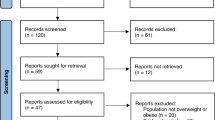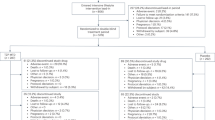Abstract
OBJECTIVE: To assess the clinical usefulness of published guidelines for the use of orlistat, by studying whether weight loss ≥2.5 kg during a 4 week dietary lead-in period, and weight losses of ≥5% after 12 weeks and ≥10% after 6 months of drug therapy predict weight loss and risk factor changes after 2 years.
DESIGN: A retrospective analysis of pooled data from 2 multicentre, randomised, placebo-controlled clinical trials with similar design.
SETTING: Twenty-nine centres throughout Europe.
PARTICIPANTS: Two hundred and twenty men and women (BMI 28–43 kg/m2) who completed 2 years of treatment.
INTERVENTION: After a 4 week hypocaloric diet plus placebo, 2 years of treatment with orlistat 120 mg tid, plus a hypocaloric diet for the first year and a weight maintenance diet in year two.
MAIN OUTCOME MEASURES: Weight loss and obesity-related risk factor changes.
RESULTS: Weight loss ≥5% body weight after 12 weeks of diet plus orlistat therapy was a good indicator of 2 year weight loss, whereas weight loss of ≥2.5 kg during the 4 week lead-in and ≥10% after 6 months did not add significantly to the prediction of 2 year outcomes. Patients who lost ≥5% of their weight at 12 weeks (n=104, 47.3%) lost significantly more weight after 2 years than others: −11.9% (95% confidence interval (CI) −13.4% to −10.3%) vs −4.7% (−5.7% to −3.7%) (P=0.0001), and had significantly greater reductions in total cholesterol, LDL-cholesterol, triglycerides, glucose, insulin, and blood pressure. Among those who achieved ≥5% weight loss at 12 weeks, the overall health benefits were not significantly greater in patients who went on to lose ≥10% body weight at 6 months compared with those who did not achieve ≥10% weight loss by month 6.
CONCLUSIONS:Of the criteria currently suggested for assessing response to orlistat treatment, weight loss of ≥5% at 12 weeks accurately predicts sustained improvements in weight and major risk factors at 2 years, while other suggested criteria are less useful.
This is a preview of subscription content, access via your institution
Access options
Subscribe to this journal
Receive 12 print issues and online access
$259.00 per year
only $21.58 per issue
Buy this article
- Purchase on Springer Link
- Instant access to full article PDF
Prices may be subject to local taxes which are calculated during checkout



Similar content being viewed by others
References
Pi-Sunyer FX . A review of long-term studies evaluating the efficacy of weight loss in ameliorating disorders associated with obesity. Clin Ther 1996; 18: 1006–1035.
Goldstein DJ . Beneficial health effects of modest weight loss. Int J Obes Relat Metab Disord 1992; 6: 397–415.
Williamson DF, Pamuk E, Thun M, Flanders D, Byers T & Heath C . Prospective study of intentional weight loss and mortality in never-smoking overweight U.S. white women age 40–64 years. Am J Epidemiol 1995; 141: 1128–1141.
Kramer FM, Jeffery RW, Forster JL & Snell MK . Long-term follow-up of behavioral treatment for obesity: patterns of weight regain among men and women. Int J Obes 1989; 13: 123–136.
Wadden TA . Treatment of obesity by moderate and severe calorie restriction: results of clinical research trials. Arch Intern Med 1993; 119: 688–693.
National Task, Force on, the Prevention, and Treatment & of Obesity . Long-term pharmacotherapy in the management of obesity. JAMA 1996; 276: 1907–1915.
Bray GA & Greenway FL . Current and potential drugs for treatment of obesity. Endocrine Reviews 1999; 20: 805–875.
Scheen AJ & Lefebvre PJ . Pharmacological treatment of obesity: present status. Int J Obes Relat Metab Disord 1999; 23 (Suppl 1): 47–53.
Astrup A & Rössner S . Lessons from obesity management programmes: greater initial weight loss improves long-term maintenance. Obes Rev 2000; 1: 17–19.
Guy-Grand B, Apfelbaum MN, Crepaldi G, Gries A, Lefebvre P & Turner P . International trial of dexfenfluramine in obesity. Lancet 1989; ii: 1142–1145.
Weintraub M, Sundaresan PR, Madan M, Schuster B, Balder A, Lasagna L & Cox C . Long-term weight control study I (weeks 0 to 34). The enhancement of behavior modification, caloric restriction and exercise by fenfluramine plus phentermine versus placebo. Clin Pharmacol Ther 1992; 51: 586–594.
National Institutes of Health. National Heart Lung and Blood Institute. Clinical guidelines on the identification, evaluation and treatment of overweight and obesity in adults. National Institutes of Health: Bethesda, MD; 1998.
Royal College & of Physicians . Clinical management of overweight and obese patients: with particular reference to the use of drugs. Royal College of Physicians: London; 1998.
National Institute for Clinical Excellence. Orlistat for the treatment of obesity in adults. Available from:http://www.nice.org.uk/pdf/orlistatguidance.pdf 2001.
Sjöström L, Rissanen A & Andersen T et al. Randomised placebo-controlled trial of orlistat for weight loss and prevention of weight regain in obese patients. Lancet 1998; 352: 167–173.
Davidson MH, Hauptman J, DiGirolamo M, Foreyt JP, Halsted CH, Heber D, Heimburger DC, Lucas CP, Robbins DC, Chung J & Heymsfield SB . Weight control and risk factor reduction in obese subjects treated for 2 years with orlistat. JAMA 1999; 281: 235–242.
Rössner S, Sjöström L, Noack R, Meinders AE & Noseda G . Weight loss, weight maintenance and improved cardiovascular risk factors after 2 years treatment with orlistat for obesity. Obes Res 2000; 8: 49–61.
European Agency for the Evaluation of Medicinal Products. Committee for Proprietary Medicinal Products European Public Assessment Report (EPAR): Xenical. EMEA: London; 1998. Available from: http://www.eudra.org/humandocs/humans/epar/xenical/xenical.htm
Lean MEJ . Is long-term weight loss possible? Br J Nutr 2000; 83 (Suppl 1): S103–S111.
Winer BJ . Statistical principles in experimental design. 2nd edn. McGraw-Hill: New York; 1971.
Sandage BWJ, Loar SB, Cary M & Cooper GL . Predictors of thera-peutic success with dexfenfluramine. Obes Res 1995; 3: 355S. Available from: http://www.fda.gov/ohrms/dockets/ac/95/3107tla.pdf
James WPT, Astrup A, Finer N, Hilsted J, Kopelman P, Rössner S, Saris WHM & Van Gaal LF . Effect of sibutramine on weight maintenance after weight loss: a randomised trial. Lancet 2000; 356: 2119–2125.
Acknowledgements
The authors acknowledge the assistance of Bokai Xia with all of the statistical analyses. This study was supported by a research grant from F. Hoffmann-La Roche (Basel, Switzerland). KRS is employed by Hoffmann-La Roche.
Author information
Authors and Affiliations
Corresponding author
Rights and permissions
About this article
Cite this article
Rissanen, A., Lean, M., Rössner, S. et al. Predictive value of early weight loss in obesity management with orlistat: an evidence-based assessment of prescribing guidelines. Int J Obes 27, 103–109 (2003). https://doi.org/10.1038/sj.ijo.0802165
Received:
Revised:
Accepted:
Published:
Issue Date:
DOI: https://doi.org/10.1038/sj.ijo.0802165
Keywords
This article is cited by
-
Review of Advances in Anti-obesity Pharmacotherapy: Implications for a Multimodal Treatment Approach with Metabolic Surgery
Obesity Surgery (2019)
-
The relationship between early weight loss and weight loss at 1 year with naltrexone ER/bupropion ER combination therapy
International Journal of Obesity (2016)
-
Longitudinal Weight Loss Patterns and their Behavioral and Demographic Associations
Annals of Behavioral Medicine (2016)
-
Interpreting weight losses from lifestyle modification trials: using categorical data
International Journal of Obesity (2010)
-
TNF‐α Promoter Methylation as a Predictive Biomarker for Weight‐loss Response
Obesity (2009)



